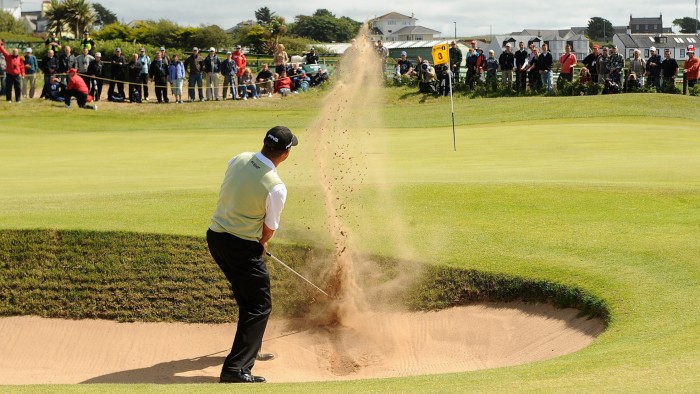Five miles south of Donald Trump’s golf resort in Turnberry, heavy articulated lorries trundle relentlessly along Girvan’s narrow one-way thoroughfare, Dalrymple Street, clogging traffic in the harbour town
The gnarly traffic of this Ayrshire town, a bane for many locals, illustrates the logistical trials marring the US president’s dream of the world’s oldest professional golf championship, the Open, returning to the Scottish course.
The resort last held the Open in 2009, with about 120,000 spectators in attendance. “It was hell to get to,” said one senior sports executive who was there. “We took a helicopter.”
The A77, the slowest trunk road in Scotland, connects the south-west port of Cairnryan, the fastest ferry crossing point between Great Britain and Northern Ireland, to the populous central belt.
But from Cairnryan northwards as far as Ayr heavy freight vehicles snarl up traffic on the single carriageway of this busy trade corridor. Several towns and villages along the road, such as Girvan — the closest railway station to Turnberry — do not have bypasses.
Mark Darbon, chief executive of the R&A, golf’s governing body, has cited the “logistical and commercial challenges” around road and rail transport, as well as accommodation, as the main barriers to the Open returning to the “brilliant golf course” at Turnberry.

The R&A is looking at ways to “get around” them but says showcasing the championship to the maximum number of people is vital for its model of reinvesting profits back into the sport.
Its revenues came to £46mn in 2009, when Turnberry last held the Open. Revenues have surged since then, exceeding £151mn in 2023, giving the R&A funds to plough back into the game.
The R&A, whose holding company is beneficially owned by the Members of The Royal and Ancient Golf Club of St Andrews, is aiming to invest £200mn into golf over a 10-year period (2017-26).
The UK government has been in talks with the R&A to allow the Open to return to Turnberry, after the US president’s team in February raised that possibility during Prime Minister Sir Keir Starmer’s visit to the White House.

John Swinney, Scottish first minister, said he was happy to be involved in any dialogue “to make sure Scotland is an attractive location for events”. Swinney has previously vowed to use Trump’s affinity to Scotland as leverage in trade talks with the US.
The UK and US have already sealed the first pact of Trump’s trade war, although critics warn it is narrow and fails to reverse the 10 per cent tariff that applies to most British goods.

Back in 2019, as preparations for Royal Portrush in County Antrim hosting its first Open, the Northern Irish government invested £17mn in urban regeneration, including upgrading the train station.
When the Open returns to Portrush in July the R&A is expecting to host 280,000 visitors, whereas the last Turnberry Open managed little more than 120,000.
About £100mn would be needed to upgrade transport infrastructure and make Turnberry a viable Open site once more, said one person close to the situation.
“It’s pretty clear that, given the straitened public finances — and benefit cuts — it would be a hard sell to spend that much of taxpayers’ money on this one project,” the person said.
At the thatched-roof Souter’s Inn restaurant, Kirkoswald, a few miles from Turnberry, Michael Poggi dismisses such logistical concern.
“The infrastructure has improved drastically,” said Poggi, a director of hospitality company Costley & Costley. “The Open brings incredible business to this area — you get people coming for three years each side of the actual event.”
He, and other residents, say the A77 and a parallel coastal road could be turned into a one-way system to ease traffic flow. The broader south-west coast region, along with Glasgow, could also accommodate enough visitors.
Locals point out that St Andrews in Fife, the spiritual home of golf that has hosted the most Opens, has similar access chokepoints and its train station, Leuchars, is five miles from the town. Muirfield, on the North Berwick coast, which last held the tournament in 2013, has also faced transportation chaos, they added.
“With the one-way system, plenty of parking available around the site and fields at the back of the hotel that were also used in 2009 for tents, the Open is perfectly possible here,” said one Turnberry member — before an employee sidled up in an electric Range Rover to demand that the Financial Times “remove” itself from the property.

Campaigners have long argued for government to address chronic under-investment in the A77 and nearby A75, from Stranraer to the English border at Gretna. They describe them as dangerous roads unfit for purpose given their roles in facilitating trade and tourism.
The Scottish government said it was committed to investing in improvements to the safety, resilience and reliability of both the A77 and A75.
“As the Open championship has grown, Ayrshire’s ageing transport infrastructure has not kept pace,” said Brian Whittle, Conservative MSP for south Scotland.
Successive Scottish governments had pledged improvements to the A77 but “words have rarely turned into action,” he added, contrasting Holyrood’s obsession with dual roads in the north-east — at the south-west’s expense.
“The biggest barrier to bringing the Open back to Turnberry isn’t the politics of its owner,” said Whittle. “It’s the legacy of decades of under-investment by both Scottish and UK governments.”
Data visualisation by Anna Marie Alcantara




